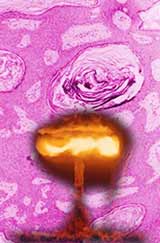Nuclear weapon blasts tumours

Radioactive reactions could blast cancers cells from within. <br>© Photodisc / NSU
A miniature radioactive reaction wipes out cancer cells
A tiny nuclear bomb planted inside cancer cells blows them apart. US researchers are turning nuclear waste into potent weapons to target tumours.
Currently, the radiation used to kill cancerous cells is difficult to aim and can hit surrounding healthy tissue. Using antibodies that recognize cancer proteins and are taken up into cells, researchers at the Memorial Sloan-Kettering Cancer Center in New York are sneaking radioactivity directly into cancerous cells1.
The team attaches the radioactive element actinium-225 to the antibodies. This unstable atom decays to release high-energy alpha particles, a potent but short-range form of radiation that kills only a few surrounding cells. Cancerous mice injected with the combination often survive longer, the group shows, and their tumours shrink.
„This approach is exciting,“ says Paul Carter, who works on antibody targeting at Immunex Corporation in Seattle, Washington. Actinium-225 is particularly potent as it makes a quadruple hit: decay triggers a chain reaction that releases four alpha particles. So the therapy would work at low doses, reducing side-effects. In contrast, targeted toxic chemicals can require thousands of molecules to kill a cell.
The radiation also kills neighbouring cells, which is advantageous for penetrating tumours. But it may harm healthy tissue, says Carter. This effect is „very short-range and hopefully beneficial,“ he adds.
Nuclear power
Finding a radioactive isotope that lasts long enough has stalled the development of targeted radiotherapy, explains Michael Zalutsky of the Duke University Medical Centre in Durham. Only two others, bismuth-213 and astatine-211 have been tried. Both have short half-lives, so have to be made and used within 46 minutes or 7 hours, respectively – otherwise they decay too much before they reach the tumour.
Actinium-225 has a 10-day half life. „You could ship it all over the world,“ says Zalutsky. „It looks very effective.“ He is pursuing clinical trials with astatine-211 on brain tumours.
The isotopes are extracted from stockpiles of nuclear waste, of which there is no shortage. David Scheinberg, leader of the Sloan-Kettering team, calls the recycling „our swords into ploughshares programme“.
As to how this approach stacks up among the arsenal of treatments being developed to fight cancer, „time and ultimately clinical trials will tell“, says Carter. Scheinberg hopes to start human trials within the next few months.
References
- McDevitt, M.R. et al. Tumour therapy with targeted atomic nanogenerators. Science, 294, 1537 – 1540, (2001).
Media Contact
Weitere Informationen:
http://www.nature.com/nsu/011122/011122-2.htmlAlle Nachrichten aus der Kategorie: Medizin Gesundheit
Dieser Fachbereich fasst die Vielzahl der medizinischen Fachrichtungen aus dem Bereich der Humanmedizin zusammen.
Unter anderem finden Sie hier Berichte aus den Teilbereichen: Anästhesiologie, Anatomie, Chirurgie, Humangenetik, Hygiene und Umweltmedizin, Innere Medizin, Neurologie, Pharmakologie, Physiologie, Urologie oder Zahnmedizin.
Neueste Beiträge

Lichtmikroskopie: Computermodell ermöglicht bessere Bilder
Neue Deep-Learning-Architektur sorgt für höhere Effizienz. Die Lichtmikroskopie ist ein unverzichtbares Werkzeug zur Untersuchung unterschiedlichster Proben. Details werden dabei erst mit Hilfe der computergestützten Bildverarbeitung sichtbar. Obwohl bereits enorme Fortschritte…

Neue Maßstäbe in der Filtertechnik
Aerosolabscheider „MiniMax“ überzeugt mit herausragender Leistung und Effizienz. Angesichts wachsender gesetzlicher und industrieller Anforderungen ist die Entwicklung effizienter Abgasreinigungstechnologien sehr wichtig. Besonders in technischen Prozessen steigt der Bedarf an innovativen…

SpecPlate: Besserer Standard für die Laboranalytik
Mehr Effizienz, Tempo und Präzision bei Laboranalysen sowie ein drastisch reduzierter Materialverbrauch: Mit der SpecPlate ersetzt das Spin-off PHABIOC aus dem Karlsruher Institut für Technologie (KIT) durch innovatives Design gleich…



